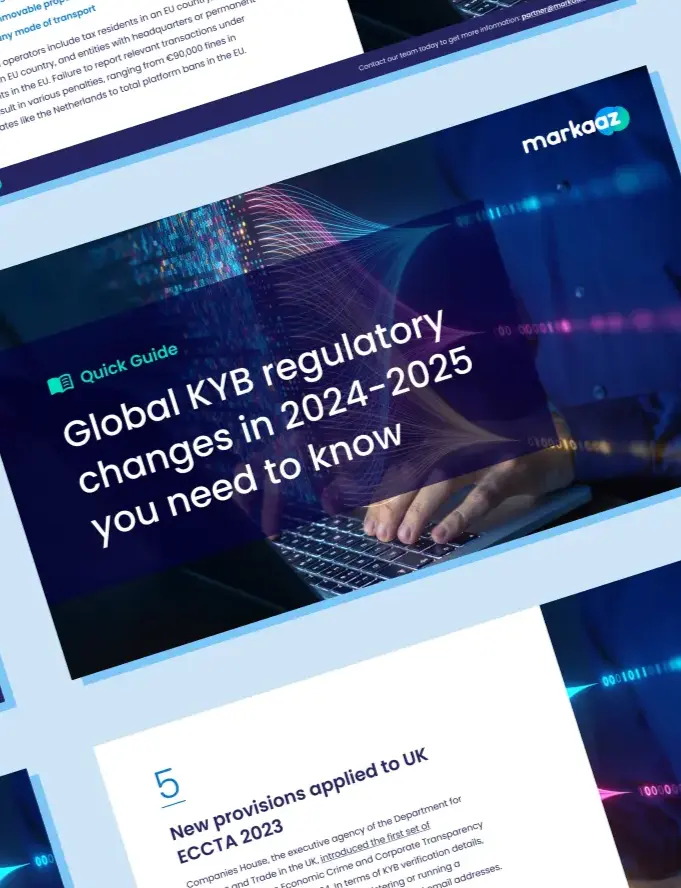Anti-money laundering (AML) regulations have put many organizations in a tough spot. By the end of 2022, global money laundering fines had seen an increase of 50%.
But AML compliance regulations are not just a financial liability. When applied properly, they can decrease your chances of being defrauded and boost your reputation, solvency, and shareholder value. By staying on top of the evolving regulatory landscape and understanding what AML compliance involves, you can avoid the financial and reputational millstone that comes with non-compliance.
AML compliance is particularly important as you onboard new and monitor current business partners. Know Your Business (KYB) identity verification and approval decisioning driven by accurate data prevents both fines and internal losses from hurting your financials.
The evolving AML regulatory landscape
Anti-money laundering involves laws and procedures that prevent businesses and people from hiding the sources of their money. Compliance regulations, particularly for the financial sector, involve rules and guidelines that mitigate the risk of fraud and doing business with organizations that practice money laundering, theft, or other financial crimes.
The KYB process is central to the AML regulatory landscape. By understanding who you’re dealing with, you can make better informed decisions regarding the questions to ask, danger signs to watch out for, or whether to do business with them at all.
Aligning with AML regulations is especially pivotal for financial institutions, insurance providers, and online retailers and marketplaces. These organizations often fall in the crosshairs of fraudulent actors, particularly because criminals can “earn” significant profits by leveraging false information. In addition, businesses that sell online can be easy targets for those who conceal their identity, hiding behind computer screens and fake information.
Keeping in step with the most recent AML regulations can be a challenge, however, because they change constantly. Many of the adjustments are in reaction to global economic changes or politics. There’s also often a need to adjust regulations for specific industries. As businesses evolve and embrace digital transformations, for example, the attack methodologies of criminals force regulators to adapt to their standards as well.
Politically exposed persons (PEPs) are another factor, and those that have abused their positions have also forced regulators to adjust their requirements.
The FinCEN Final Rule is one example of a significant change regulators have had to impose to accommodate a shifting international business climate. Starting January 1, 2024, businesses have to report their beneficial ownership information. This means they must keep track of and file information about who benefits from their business activities.
With these adjustments, financial law enforcement hopes to reduce the abuse of shell companies used to launder money through offshore businesses and other means.
Losses and compliance fines stemming from a poor onboarding process
As mentioned at the outset, compliance fines can impact an otherwise sound profit and loss statement.
Take the Binance case, for instance. Former CEO Changpeng Zhao pled guilty to an array of accusations, including receiving funds from Al Qaeda and ransomware attacks. In the end, the organization got hit with a $4.3 billion fine. Zhao paid $50 million USD out of his own pocket.
Gambling company Crown Resorts had to pay around $300 million USD, as ordered by a July 11, 2023 ruling by the Federal Court of Australia. According to the ruling, Crown Resorts failed to conduct the appropriate due diligence on customers that presented high money laundering risks. In addition, the court found that the company failed to put appropriate anti-money laundering frameworks in place.
The size of the actual fine an organization faces depends on the scope of the violation and the discretion of prosecutors, judges, or those involved in the litigation process. But the impact can be significant, as can the reputational ripple effect.
Even a company with many years of upstanding performance, honesty, and transparency can have its reputation tarnished by a single AML violation. The damage can be even more poignant in the context of terrorists, cybercriminals, and state-sponsored actors using companies to hide the sources of their funds.
In addition, the costs of investigating and settling an AML-related case can add up quickly. Factor in the cost of losing customers who no longer trust the organization, and the price can easily eclipse any fines courts may levy against a company.
In some instances, a business can lose its operating license, forcing it to shut its doors altogether. Or, as the Binance situation illustrates, one or more leaders step down to bandage the reputational wound.
For some companies, addressing an AML issue on a systemic level can easily get expensive. For instance, fixing an inefficient, error-prone onboarding process can mean revamping much of their digital infrastructure, resulting in considerable man-hours and investments in new technology.
How to build an AML compliance infrastructure
Avoiding the financial impact of AML-related incidents can be a challenge, but you can streamline your processes using:
- Customer due diligence (CDD): Make sure each customer is who they say they are and their business is legitimate.
- Enhanced due diligence (EDD): Delve deeper to uncover any issues that arise during the initial due diligence phase.
- Ongoing monitoring: Catch any changes that can indicate AML-related concerns through diligent, continual monitoring.
- Suspicious activity reporting (SAR): File a report with a financial authority. Details can be kept confidential.
- Recordkeeping: Keep accurate records to spot irregularities, such as suspiciously large transactions or spending patterns that can indicate an attempt to launder money.
- Training and awareness: Train your staff on what money laundering looks like and how to perform due diligence to spot issues early on.
- Risk assessment: Systematically assess each entity you do business with, then make data-driven decisions.
- Compliance policies and procedures: Internal compliance policies and procedures can serve as an AML buffer, helping your staff catch the same kinds of problems investigators would be looking for.
- AML compliance officer: An AML compliance officer can focus their efforts on identifying signs of money laundering and mitigating a problem before it gets worse.
Regardless of the systems you have in place, AML compliance technology can lighten your workload. With a data and technology partner like Markaaz, you get a consistent solution you can use to assess the qualifications and details of businesses you’re considering working with.
Markaaz’s KYB and AML compliance monitoring solution can help you identify partners that can result in financial exposure. In addition, Markaaz’s database of over 300 million global business records is screened against all global sanctions lists and provides daily compliance alerts, so you can assess your compliance risk on an ongoing basis, using data from the most credible sources.
Reduce risk by staying on top of regulatory changes
By staying updated, you can adjust existing systems to accommodate new regulations—before you come under the scrutiny of an audit or investigation. In this way, you safeguard the reputation, operations, and financial stability of your company. Your AML compliance process or solution provider can use the following resources to help:
- Government regulatory websites
- Industry associations
- Subscription-based services
- Legal and compliance publications
- Government news alerts
- Reputable online news and blogs
- AML software and compliance solutions, like Markaaz’s platform
- Consulting firms
- Webinars and seminars
- Social media forums
Use technology to systemically maintain compliance
Changes in the AML landscape are unavoidable. Several companies have fallen out of compliance, but you don’t have to. With careful due diligence, recordkeeping, training, and strict internal controls, you can prevent compliance problems from impacting your business.
Markaaz empowers you with consistent, reliable data, as well as ongoing monitoring, to streamline AML compliance. Our solutions can identify businesses on law enforcement and sanctions watchlists, PEPs, and more. To learn more about how Markaaz can help shield your company from AML risks, reach out for a demo today.



